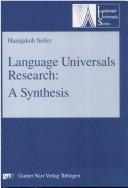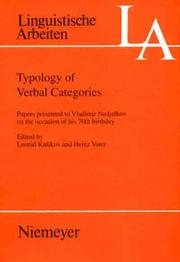| Listing 1 - 5 of 5 |
Sort by
|
Book
ISBN: 9027269610 9789027269614 9789027256546 9027256543 1322079870 Year: 2014 Publisher: Amsterdam, Netherlands : John Benjamins Publishing Company,
Abstract | Keywords | Export | Availability | Bookmark
 Loading...
Loading...Choose an application
- Reference Manager
- EndNote
- RefWorks (Direct export to RefWorks)
The change from temporal to cause is one of the well-known grammaticalization paths. This article analyses the change in the Estonian conjunction kuna, 'while; as, because' from temporal to causal one as well as the attitude of the Estonian language planners towards this change. This change has mainly taken place during the twentieth century. The end of the nineteenth century and the beginning of the twentieth century witnessed the prevailing use of the temporal use of kuna. However, during the latter part of the 20th century the use of kuna began to shift, and the use of causal kuna began to dominate. As an intermediary stage between the temporal and causal usages, kuna was used as an adversative temporal conjunction. The impact of this shift in usage of kuna as a causal conjunction has also slightly changed the use of other Estonian causal conjunctions. Initially, Estonian language planners adopted a strict attitude towards the change of kuna, but language planning could not halt this change. For example, editors continued to cross out the causal use of kuna, but they could not increase the temporal use, and this usage of the conjunction hardly appears in the written texts of the 1970s. However, the change was finally accepted in the 1990s.
Grammar, Comparative and general --- Typological (Linguistics) --- Clauses --- Subordination (Linguistics) --- Subordinate constructions. --- Clauses. --- Sentences --- Syntax --- Linguistics --- Philology

ISBN: 3823347721 3823347802 9783823347729 9783823347804 Year: 2000 Publisher: Tübingen Narr
Abstract | Keywords | Export | Availability | Bookmark
 Loading...
Loading...Choose an application
- Reference Manager
- EndNote
- RefWorks (Direct export to RefWorks)

ISBN: 3484303824 3111848663 3110913755 9783484303829 Year: 1998 Volume: 382 Publisher: Tübingen Max Niemeyer Verlag
Abstract | Keywords | Export | Availability | Bookmark
 Loading...
Loading...Choose an application
- Reference Manager
- EndNote
- RefWorks (Direct export to RefWorks)
The typological studies of this volume are oriented towards the areas of interests of the Russian typologist Vladimir P. Nedjalkov, to whom the volume is dedicated. They deal with the typology of verbal categories. The book is divided into three parts: 1. "Ergativity and transitivity", 2. "Voice, causative and valency", 3. "Tense and mood". In all three parts of the volume instances of grammaticalization are pointed out and investigated. The studies concern various languages, e.g. English, French, German, Russian, Hungarian, Dutch, Tariana (a North Arawak language from North West Amazonia), Dumi (a Tibeto-Burman language), and Lak (a Daghestanian language).
Grammar --- Grammar, Comparative and general --- Typology (Linguistics) --- Categories, Grammatical --- Grammatical categories --- Categorization (Linguistics) --- Componential analysis (Linguistics) --- Language and languages --- Linguistic typology --- Linguistics --- Linguistic universals --- Verb --- Major form classes --- Typology --- Classification --- Verb phrase --- Verbals --- Reflexives --- Nedi︠a︡lkov, V. P. --- Nedi︠a︡lkov, Vladimir Petrovich --- Nedjalkov, Vladimir P. --- Nedjalkov, Vladimir --- Grammar [Comparative and general ] --- Verb. --- Grammatical categories. --- Nedi͡alkov, V. P. --- Philology --- 17.13 typological linguistics. --- Catégories grammaticales. --- Grammatische Kategorie. --- Sprachtypologie. --- Taaltypologie. --- Typologie (Linguistique). --- Typologie. --- Typology (Linguistics). --- Verbe (Linguistique). --- Werkwoorden. --- Nedjalkov, V.P.,
Book
ISBN: 9781402088247 1402088248 1402088256 9781402088254 904817998X Year: 2009 Publisher: Dordrecht : Springer,
Abstract | Keywords | Export | Availability | Bookmark
 Loading...
Loading...Choose an application
- Reference Manager
- EndNote
- RefWorks (Direct export to RefWorks)
This book collects the contributions presented at the international congress held at the University of Bologna in January 2007, where leading scholars of different persuasions and interests offered an up-to-date overview of the current status of the research on linguistic universals. The papers that make up the volume deal with both theoretical and empirical issues, and range over various domains, covering not only morphology and syntax, which were the major focus of Greenberg’s seminal work, but also phonology and semantics, as well as diachrony and second language acquisition. Diverse perspectives illustrate and discuss a huge number of phenomena from a wide variety of languages, not only exploring the way research on universals intersects with different subareas of linguistics, but also contributing to the ongoing debate between functional and formal approaches to explaining the universals of language. This stimulating reading for scientists, researchers and postgraduate students in linguistics shows how different, but not irreconcilable, modes of explanation can complement each other, both offering fresh insights into the investigation of unity and diversity in languages, and pointing to exciting areas for future research.
Sociolinguistics --- Linguistics --- syntaxis --- linguïstiek --- 17.13 typological linguistics. --- Linguistic universals --- Linguistic universals. --- Sprachliche Universalien. --- Taaluniversalia. --- Universalia (språkvetenskap) --- Grammar, Comparative and general. --- Phonology. --- Grammar. --- Syntax. --- Phonology and Phonetics. --- Theoretical Linguistics. --- Comparative grammar --- Grammar --- Grammar, Philosophical --- Grammar, Universal --- Language and languages --- Philosophical grammar --- Philology --- Grammar, Comparative --- Linguistics. --- Linguistic science --- Science of language --- Grammar, Comparative and general Syntax --- Syntax --- Grammar, Comparative and general Phonology --- Phonology --- Universaux (linguistique) --- Grammaire comparative et générale --- Syntaxe
Book
ISBN: 3946234380 3946234372 9783946234371 9783946234388 9783946234395 9781530465996 Year: 2016 Publisher: Berlin : Language Science Press,
Abstract | Keywords | Export | Availability | Bookmark
 Loading...
Loading...Choose an application
- Reference Manager
- EndNote
- RefWorks (Direct export to RefWorks)
The Siouan family comprises some twenty languages, historically spoken across a broad swath of the central North American plains and woodlands, as well as in parts of the southeastern United States. In spite of its geographical extent and diversity, and the size and importance of several Siouan-speaking tribes, this family has received relatively little attention in the linguistic literature and many of the individual Siouan languages are severely understudied. This volume aims to make work on Siouan languages more broadly available and to encourage deeper investigation of the myriad typological, theoretical, descriptive, and pedagogical issues they raise. The 17 chapters in this volume present a broad range of current Siouan research, focusing on various Siouan languages, from a variety of linguistic perspectives: historical-genetic, philological, applied, descriptive, formal/generative, and comparative/typological. The editors' preface summarizes characteristic features of the Siouan family, including head-final and ""verb-centered"" syntax, a complex system of verbal affixes including applicatives and subject-possessives, head-internal relative clauses, gendered speech markers, stop-systems including ejectives, and a preference for certain prosodic and phonotactic patterns. The volume is dedicated to the memory of Professor Robert L. Rankin, a towering figure in Siouan linguistics throughout his long career, who passed away in February of 2014.
Siouan languages --- Indians of North America --- American aborigines --- American Indians --- First Nations (North America) --- Indians of the United States --- Indigenous peoples --- Native Americans --- North American Indians --- Languages --- Culture --- Ethnology --- E-books --- Siouan languages. --- Languages. --- Catawba-Siouan languages --- Siouan-Catawban languages --- formal/generative linguistics --- comparative/typological linguistics --- applied linguistics --- philological linguistics --- historical-genetic linguistics --- descriptive linguistics --- siouan languages --- Verb --- Verb phrase --- Language Arts & Disciplines / Linguistics --- Language arts
| Listing 1 - 5 of 5 |
Sort by
|

 Search
Search Feedback
Feedback About UniCat
About UniCat  Help
Help News
News